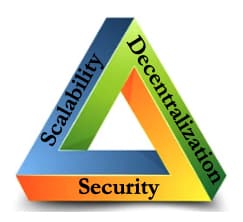The blockchain is being adopted rapidly across industries, which is a testament to the reliability of its underlying decentralised architecture. Today, blockchain use cases are common in supply chains, financial services, and healthcare, and are developing fast in many other domains. But a few challenges remain, and the choice of blockchain is critical.
There is a growing belief that the adoption of blockchain will effectively break the monopoly over data that a few global enterprises concentrated in Silicon Valley have, and that Web 3.0 will play a critical role in end user participation and decentralisation of data. The fundamental premise of blockchain is that there is no central authority — it’s governed by a network of users who establish the rules of participation, which evolve according to consensus. Lack of central control allows for a decision-making mechanism in which a large group of people participate.
The World Wide Web was developed as a decentralised platform. It evolved into Web 2.0, which helped a few individuals tap into data and grow into global enterprises at breathtaking speed. Web 3.0, which is the next evolution of the World Wide Web, is expected to decentralise the control of data. In fact, the backbone of digital currency is the blockchain and its decentralised architecture. Bitcoin and Ethereum are popular cryptocurrencies today.
Current social and business structures have long been hierarchical in nature. The top-down command and control paradigm needs to evolve into a less centralised consensus mechanism. This involves a fundamental shift of how everything operates today; so it’s going to be a while before effective models evolve into platforms for mass adoption.

Conway’s Law states: “Organisations that design systems are constrained to produce designs that are copies of the communication structure of these organisations.” This reflects the paradigm shift necessary for innovative solutions like blockchain to flourish.
In a federated blockchain or consortium blockchain like Hyperledger, where the participants are pre-selected and accepted, security and scalability can be managed in a controlled way. However, in a public or permissionless blockchain, anyone can participate, which makes it challenging to predict the scalability necessary for the blockchain system to function optimally.
Blockchain: The trilemma dilemma
The popular triple constraint theory has been elaborated and applied to blockchain by Vitalik Buterin as the ‘blockchain trilemma’. It addresses the challenges technologists face in creating blockchain platform architecture that’s decentralised, scalable, and secure.
A decentralised blockchain system empowers permissionless ownership, where anyone can use and build on the platform. Decisions with respect to transactions are made by way of consensus by a group of nodes. A consensus verified transaction is permanent and cannot be altered. Bitcoin, Ethereum, and other such cryptocurrencies suffer from slower performance as transactions grow, as they need to be confirmed by a single entity by design. There is light at the end of the tunnel, though, in newer ways of implementation; one prime example is Ethereum 2.0.
Scalable blockchain systems are able to handle growth in transactions gracefully. This is the most important aspect of any system for enabling mass adoption. However, this aspect of design is still in the works with respect to finding true solutions that would challenge current central authority-based scalability systems.
Secure blockchain systems self-manage their defence from attacks, bugs, and unforeseen issues. It’s hard for blockchains to adhere to transparency at the source code level and still achieve a great amount of security. This is another area of work in progress.
Irrespective of whether one believes in the blockchain trilemma or not, it is true that building a reliable blockchain system that provides decentralisation, scalability, and security is a difficult undertaking for enterprises across all industries. In addressing these challenges, multiple types of blockchains have evolved over the years.
Types of blockchains
What started as permissionless public blockchain technology has evolved into multiple types of blockchain combinations — public/private and permissionless/permissioned. An enterprise can choose the type of blockchain that inherently addresses most of its primary concerns as part of the framework.
While the blockchain has advantages like improved trust, security and speed; lower costs, and smart contracts, it does suffer from a few disadvantages. It is extremely difficult to modify data in a blockchain; it requires large database storage, and the private key is irrevocable even in case of loss. The selection between permissionless and permissioned blockchain becomes critical for an enterprise.

Although there are four types of blockchains, they largely boil down to public or private blockchains. The way in which these are deployed for management creates two other types of blockchains — consortium and hybrid. Public blockchains are permissionless and are decentralised peer-to-peer networks, whereas private blockchains are permissioned and the ledger is controlled by a centralised authority. Hybrid blockchains are part public and part private, with some parts of the system permission-based and some parts being permissionless. Lastly, consortium blockchains are federated with a set number of organisations working in collaboration. These choose to make some parts public and some private, including the ability to make a specific transaction public by using smart contract-based governance.
There is a lot more that goes into understanding each of the blockchain types along with their characteristics. An organisation interested in using a blockchain would have to review its requirements and answer a series of questions that help navigate the web of possibilities across all the four types of blockchains. Only then can it decide as to which type is better suited for its needs. Irrespective of the model an organisation chooses, there will always be compromises that would have to be made. How efficiently a blockchain is managed without impacting the overall security, scalability, and reliability of the system depends on its design and implementation. Typically, it’s difficult to change the type of blockchain once a path is chosen; so it is important to ensure all the characteristics are well understood before embarking on the enterprise blockchain journey.
At the end of the day, blockchain is an asset that will help enterprises increase their reach with customers. By building streaming and time series integrated analytics for the blockchain, organisations can address the challenges of stale data on legacy systems with fresh intelligence in real-time, creating an everlasting impression on customers.
What is evident is that a decentralised, user-driven, social consensus way of developing technology has arrived. What remains to be seen is governments adopting it for social causes and enterprises for end user transparency. There is little doubt that blockchain is a revolutionary technology that’s destined to have a disruptive impact on the way technology is applied in everyday life.




